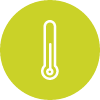Caring for the environment
The digitalisation of services has been an ongoing process in the NLB since 2012 as we have introduced electronic statements, e-invoices and e-business with clients as part of our efforts to bring about a ‘green office’. We have also reduced the amount of paper used at meetings. Employees can only print their documents on shared printers, which are automatically set to print double-sided and in black and white.
Power consumption
Compared to 2010, annual energy use dropped by 41.2%, or around 9,500,000 kWh. In 2016, consumption was 9.7% lower than in the previous year.
Use of renewable sources – paper
Paper consumption per employee fell by 2.9% in 2016 compared to the previous year. Total paper consumption dropped by 5.8% in 2016 over the previous year.
| Year | Number of A4 paper per employee per day |
|---|---|
| 2011 | 36.1 |
| 2012 | 40.8 |
| 2013 | 36.7 |
| 2014 | 42.0 |
| 2015 | 40.8 |
| 2016 | 39.6 |
| Year | Total use of A4 paper per year |
|---|---|
| 2011 | 33,770,000 |
| 2012 | 36,282,000 |
| 2013 | 31,390,000 |
| 2014 | 32,739,000 |
| 2015 | 31,671,000 |
| 2016 | 29,830,000 |
Waste
In 2016, in all locations we stopped the use of the old waste bins. We are now using only so-called waste segregation islands or eco-islands, where employees have to separate waste by material. We started with this practice in 2010.
In 2016, we recycled the following ...
Raising awareness of the rational use of sources and recycling
In 2016, expert services continued to remind the employees that everyone can contribute to the more rational use of energy for heating. They recommended limiting the heating in winter to 20–22 °C, and the air conditioning in summer to above 25 °C. Our employees are aware that each degree above these recommendations results not only in a heavier carbon footprint, but also over 5% higher heating and air conditioning costs.

Appropriate segregation of waste material




Empty bottles and other waste material, which do not go into any of the containers at the eco-island, are placed next to the eco-island – to be removed by the cleaning service.
Disclosures by GRI Standards
Environmental indicators
GRI STANDARD, DISCLOSURE 301-1
We report on the quantity of materials used. According to disclosure 301-1aii. we report 39.62 A4 sheets of paper per employee per day, representing renewable materials used in the performance of NLB d.d. services in 2016.
GRI STANDARD, DISCLOSURE 302-1
We report on energy consumption within the organisation. According to disclosure 302-1ai. we report 13,620,000 kWh electricity consumption at NLB d.d. in 2016.
GRI STANDARD, DISCLOSURE 306-2
We report on waste by type for NLB d.d. in 2016: 432,925 kg of municipal waste, 42,514 kg of cardboard and paper, 1,660 kg of wood, 45,672 kg of electronic equipment, 500 kg of textile coverings, 200 kg of hydrogen fluoride, 1,400 kg of oil and grease and 243 kg of batteries and accumulators.
GRI STANDARD, DISCLOSURE 307-1
We report on non-compliance with environmental laws and regulations. NLB d.d. was not imposed with any fines or non-monetary sanctions for non-compliance with environmental laws.
